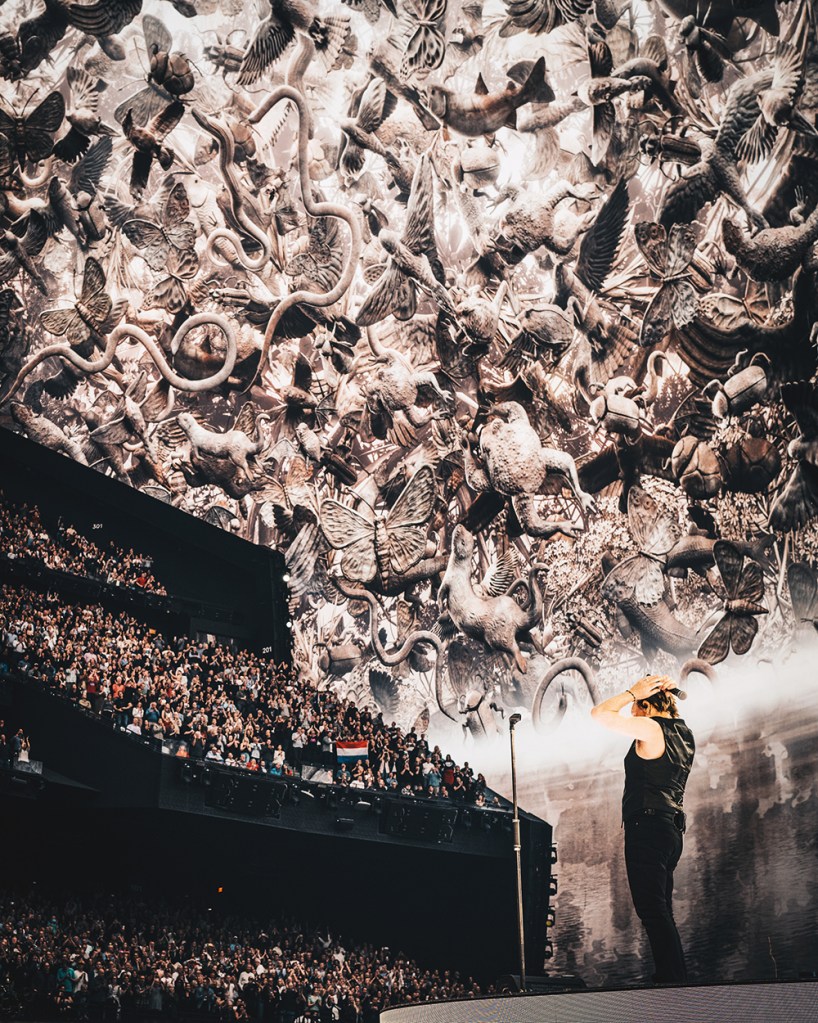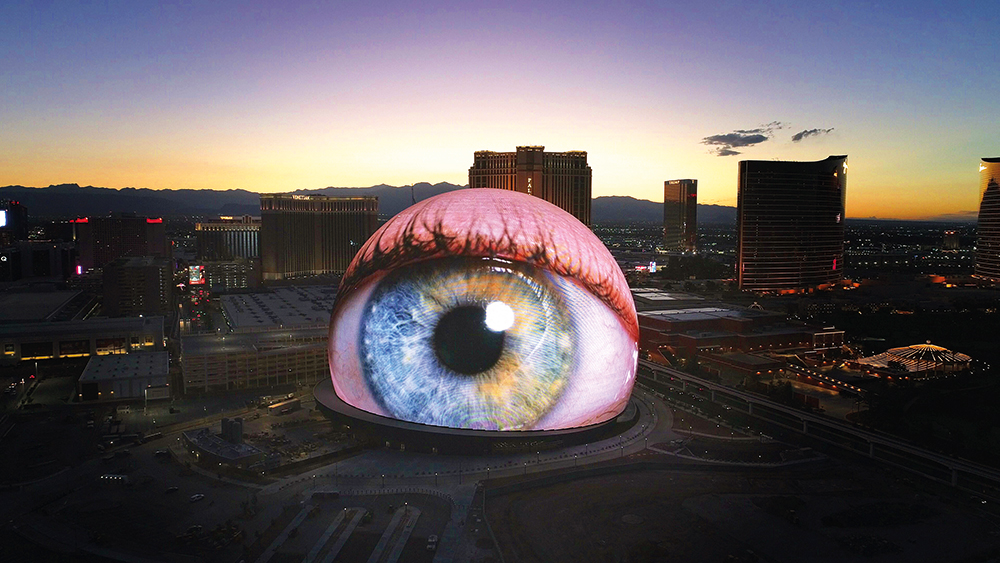Robert Jackman has narrated this article for you to listen to.
Does Elon Musk have a good eye for the aesthetic? Earlier this month, the Tesla magnate took a break from his incessant political posting to praise something he described as a ‘work of art’ – the Las Vegas Sphere. He then treated his 200 million Twitter followers to a video of an awed crowd, desperately angling their phones to capture the supposed majesty of the Sphere.
Admittedly, it was hardly the first time that the Sphere has gone viral on social media. Since its grand opening last autumn, this very modern monument has had a knack for conquering the internet, with videos of its optical illusions prompting both awe and disgust. Its occasional surreal turns (like when it turned into a giant cartoon emoji, side-eyeing the Las Vegas skyline) have made headlines in their own right.
The whole thing happened so quickly my brain didn’t quite know what to make of it
How impressive is the Sphere in reality? On a balmy September night in Las Vegas, I get my first unfiltered experience of the giant structure in person. As I stand and stare from a car park some half a mile away, its 350ft dome is pulsing with hypnotic patterns as it advertises an upcoming event due to take place within its gigantic spherical casing.
Even from this distance, it’s not hard to see why the Sphere has mesmerised so many. With its entire external structure clad in a seamless quilt of curved LED screens, it resembles less a video installation and more a planet-shaped portal, thrusting its images to the forefront of your consciousness.
Almost instinctively, I find myself reaching for my phone, holding up its much smaller screen in a ritual display of inferiority. As I angle for the perfect shot, I recall an article about how the Sphere’s unveiling had coincided with an increase in traffic accidents, the result of drivers distracted by its Siren-like glare.
What exactly is the Sphere? It depends on whom you ask. To its evangelists, it is nothing less than the future of live arts: a revolutionary concept which will reshape how we interact with music, film and sport alike. To its critics, it is a gaudy spectacle designed to add an extra zero to the price of your average concert ticket. The idea clearly has a wider appeal – there are plans to build a mini-Sphere in Dubai.
Could they both be right? Take the Sphere’s inaugural show, which ran from September last year to this March: a six-month U2 residency. The band performed their 1991 breakthrough album Achtung Baby in front of immersive visuals intended to reshape the audience’s reality. Videos on social media captured the show’s breathtaking start, as the Sphere’s concave interior appeared to part like a river, ushering in ecstatic bursts of light in tune with the band’s opening riffs.
The show didn’t just go viral; it smashed records. Grossing more than $240 million over 40 dates, it was officially the most lucrative Las Vegas residency (in terms of revenue per show) in history. The Sphere’s backers hope it will be just the start – although it’s not quite clear of what.
Shortly after I arrive in town, the Sphere achieves another milestone when it hosts its first ever live sporting event: an outing of the Ultimate Fighting Championship, the billion-dollar cage-fighting spectacle that has become a fixture of Vegas nightlife. Like anything involving the Sphere, the hype isn’t exactly subtle, with the UFC’s chief executive promising no less than ‘the greatest sporting event of all time’.
With tickets changing hands for $3,000, I opt to watch from a casino sports bar instead. Even from there, it’s hard not to be impressed by the opening moments – as a procession of what could be life-sized asteroids pass over the eyeline of the audience, accompanied by a bombastic voiceover from actor Gael Garcia Bernal.
The next day I resolve to buy tickets for something called Postcard from Earth, the Sphere’s resident cinematic experience and one of the biggest tourist draws in Sin City. It’s directed by Darren Aronofsky – creator of The Whale and Requiem for a Dream, and perhaps one of the most successful chroniclers of human misery. In other words, not a director whose work is crying out to be projected onto the world’s biggest screen.
As it turns out, Postcard from Earth is more than a slight departure from Aronofsky’s usual style. Much of it veers between crowd-pleasing natural documentary (glaciers, canyons, wildlife, etc.) and what appears to be a homage to Koyaanisqatsi, the experimental 1982 film known for its zoomy montages of urban life. Rather bizarrely given our immediate surroundings, there’s also a hokey plot about climate change and the perils of human excess.
Has Aronofsky toned down his usual shtick in return for a windfall pay day? As I watch a flurry of giraffes frolicking in front of my eyes, I fear that might be the case. But there are also times when I figure there might be a more innocent explanation: perhaps he was just having fun with the technology.
Take the film’s opening scene, set in a spaceship hovering above Earth. At first, the whole thing plays out within a large, rectangular screen which, while almost certainly twice the size of your average IMAX, doesn’t exactly suggest we’re witnessing the height of technology. Leaving us hanging there just long enough to wonder if we’ve been conned, the camera suddenly pans to the window and a panoramic shot of Earth explodes into view, expanding to fill the entirety of the room. The whole thing happened so quickly my brain didn’t quite know what to make of it.

There were some other clever bits. An over-the-shoulder shot of worshippers in a mosque felt unbelievably lifelike and oddly transgressive. And some of the scenic stuff was so disorienting I had to look down at my feet to regain my balance. At one point, the seats started moving and vibrating, parts of the audience cooing with awe – but I’m sure I remember experiencing this technology at Alton Towers as a child in the 1990s.
The Sphere’s next cinematic endeavour is an ultra-high-definition remastering of The Wizard of Oz (1939). According to reports in the US media, it will cost $80 million to bring the film up to the standard needed to suit the state-of-the-art 16k screen. Tickets should be on sale next year.
As for live music, this month will see the start of a new residency from the Eagles, who are due to play until early next year. Admittedly, it’s a slightly odd choice given that, on their last stadium tour, the band’s frontman made a point of boasting about the lack of flashy pyrotechnics and stagecraft, describing the group as ‘just a bunch of guys with guitars’. And the Sphere is not without its pitfalls: U2 reportedly had to remove one effect for fear of prompting mass-vomiting.
Critics may carp that what’s being worshipped here is nothing more than a glorified screensaver
These are mere details to the owner, James Dolan, who has begun talking up the surreal prospect of having sister venues dotted across the world, like space-age temples. Before the pandemic, he even tried – unsuccessfully – to bring the concept to London.
Dolan’s MSG group first submitted plans for a London Sphere in 2018, around the same time as the Las Vegas project was getting under way. The idea got the initial go-ahead from Whitehall, with MSG looking to secure an east London location, before eventually being blocked by London Mayor Sadiq Khan last November. Locals had lobbied City Hall, fearing – not without reason – that the presence of a gigantic LED dome may affect the quality of their sleep.
‘It appears that Sadiq Khan took the saying “what happens in Vegas, stays in Vegas” a little too literally,’ was the response of Matt Hancock, who held the culture brief at the time of the original application.
I will gladly add my name to those calling for a rethink. I watch the crowds teeming out of the Sphere and walking back towards the glow of the Las Vegas strip. They seem happy enough to me. Critics may carp that what’s being worshipped here is little more than a glorified screensaver. Yet cinema was met with similar disapproval during its first few decades. Besides, the Sphere isn’t struggling to bring in the punters, with 60,000 people a week paying the price of a Broadway ticket to attend.
How many end up feeling underwhelmed? It’s hard to know. Certainly no one appeared to be looking for a refund. On the contrary, most were more concerned with grabbing one last photo.







Comments